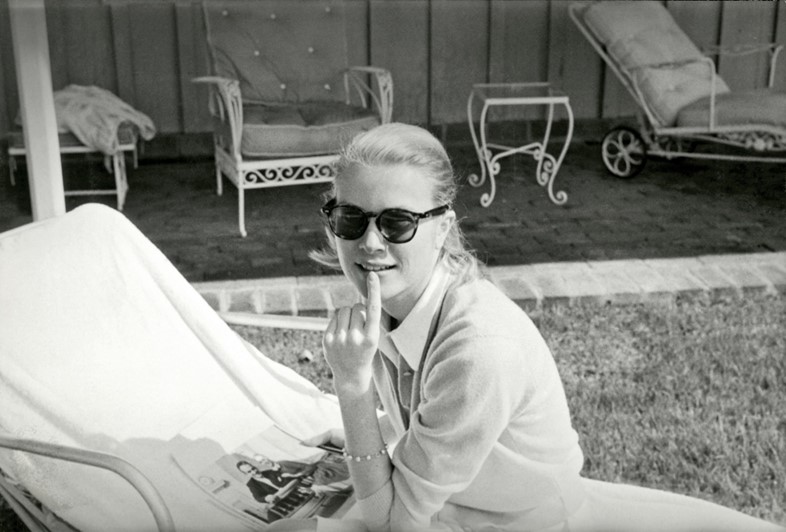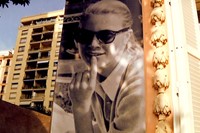We speak to Princess Caroline of Hanover about her involvement with Pringle of Scotland’s layered Archive Project, her recollections of her mother's style and working with Professor Louise Wilson
Reflections on Princess Grace’s sense of style tend towards the dramatic, focusing on the couture and fine ready-to-wear she wore as the reigning queen of Hollywood and later as Her Serene Highness the Princess of Monaco. Her style at home there was much more relaxed, however, as her daughter, Caroline, Princess of Hanover remembers, often favouring cashmere knits and twinsets. “My mother wore these in a relaxed, family context. It was a more informal side which of course had no reason to be seen or shown in other exhibitions.”
She is speaking these words over lunch on a fittingly serene summer’s day in the beautiful Hotel Metropole in Monaco, dressed simply and chicly in white trousers and black top, accessorised with a silk neck scarf and a pair of brightly coloured skate shoes. Chanel is a favoured designer but we are here to talk about her involvement with Pringle of Scotland’s layered Archive Project and the exhibition Princess Grace: More Than An Image, which showcased items selected by Central Saint Martins BA fashion students from the archives of Princess Grace, a devoted customer of the heritage brand. These items – including photographs and Super 8 home movies – in turn inspired a 2013 capsule collection for Pringle of Scotland designed by the MA fashion students under the tutelage of Louise Wilson, the director of the course. It was a unique collaboration between the brand, Central Saint Martins and the Nouveau Musée National de Monaco, of which the Princess is a patron.
Heritage and education are subjects close to her heart, and she has graciously agreed to talk to me about the project and the late, formidable Professor Louise Wilson. It is only a few weeks since Wilson tragically passed away and her loss is keenly felt. “She was someone I wish I had got to know better,” reflects the Princess.

Articulate and warm, her conversation is sprinkled with sage words from Goethe to Mahler and she is happy to talk about her memories of her mother in Pringle of Scotland. Many of her mother’s clothes she kept and continues to wear. She tells the story of meeting the students wearing her mother’s grey and black cashmere dress from 1962, still a perfect fit. “I’ve had these things for years, and I’ve worn them since I was 20. If they’re made properly they’re indestructible.” Her intimate recollections offer a glimpse into the real Princess Grace, stripped back from the misrepresentations and inaccuracies that continue to swirl around her. “There are two words I hate and despise and don’t want to hear: red carpet and iconic,” says Princess Caroline, firmly. “It was important to talk about the students and put their work forward and the light on them.” What unfolds is a tribute to their hard work, Louise Wilson’s dedication to her students and a portrait of the real Princess Grace, the woman behind the image.
What were your initial thoughts about the collaboration?
When we were first approached, I thought for once it was something that was not stale. I’ve said it before, I always am very wary of old clothes. Louise and I agreed on that, we had a long discussion, nothing is sadder than old clothes. It’s gloomy and I’d had to reluctantly see all these exhibitions on my mother’s clothes. It’s nice that people love to see them but for me it’s irrelevant because it’s not that person. That was the interesting part, as she was such a faithful and enthusiastic customer of Pringle’s. What would she have worn today, if they were transposed to a different time? It was such a serious project and so thorough and rigorous in its method and its goals that I though it was something really worth following. I just gave a few hints and then found a few things that made, as we say in French, “pistes” or little tracks that they could explore. It was a delight working with the whole team.
“There are two words I hate and despise and don’t want to hear: red carpet and iconic"
What were your personal impressions of Louise?
She had such tremendous knowledge; she was encyclopaedic in her knowledge of fashion and history. She was really “en retrait” [she kept back]; she really let her students do their work. It was lovely to see. There was a sort of trust, you could see. She did prepare them for what their life would be afterwards. It’s true you can be sort of the star of your school, doing well in a little world, and then when you land in the real fashion world, which is ruthless, it can be very hard. I think indirectly she prepared them for that. I don’t know what she put first – fashion or education. I think education. Disguised as fashion.
What was the working process like? Were you pleased with the way the BA students were interacting with the archive?
It all went so smoothly and happily I must say. They were hugely receptive. Marielle, she’s retired, she was our head laundress. She started at 16 at the palace and then she ran the whole place like a second housekeeper. She arrived just before I was born and she still remembers everything so immediately we put Marielle in contact with the students and the whole team and it was the time of her life. She actually was the key person; she’s probably more part of the project than I am.
"Louise Wilson had such tremendous knowledge; she was encyclopaedic in her knowledge of fashion and history"
What kinds of items were uncovered from the archive?
We had a lot of trouble finding things because of course they were everyday, informal clothes and I think my mother gave a lot away to her friends or cousins or sisters. Marielle confirmed a lot was given away. And then times change. I pinched a few when I was 16, 17. There was a green suit that she wore in Ireland on a summer holiday, a cashmere Kelly green skirt and top with three quarter sleeves that I’ve seen in some black and white pictures but few colour pictures exist. And that skirt and top of course disappeared. I remember it clearly, I was six, and we were on a family holiday in Ireland. It was her sort of relaxed countryside outfit.
I was wondering if you might be able to talk me through a particular look, for example the caftan piece?
The caftan was actually inspired from a Madame Grès dress from the late 60s, a white and grey dress from a photograph of my mother. My mother did wear a lot of caftans, she got them in Tunisia, Morocco.
Did you feel that the looks reflected the personal style of your mother at home in her surroundings here in Monaco?
From a period. My mother, certainly in the last ten, 15 years of her life would dress completely differently. She would have gone more for very warm clothes, because she was always cold, the houses were super heated and of course she always had a cold from being over-heated. She would always have a scarf, cashmere shawls. She actually had a lot from Pringle, the ones with little ruffles around and always in mid-summer. And then she had these rather larger knits in the 70s and long jackets with the belts, she loved those.
"I never saw my mother in jeans, even in the country"
How would you describe your mother’s personal style in Monaco?
In Monaco she was always quite formally dressed, in the office and when she would receive people in her mansion. There was a rule: no trousers, or slacks, as Americans call them, in the palace. I never saw my mother in jeans, even in the country. She had one pair, which I have, but she never wore them. They were from Rear Window, in the end when she’s wearing jeans and loafers and a shirt. They were comfortable things that zip at the back, with really tight little pleats. They’re very dark, they’re not proper denim.
How would you describe your own personal style? To what extent have you been influenced by your mother’s sense of style?
Well, it’s personal; I’m probably confused. I grew up in a uniform at school, and I sort of wish that I still had one and made to dress certain ways. My mother used to pick my clothes, I had hand-me-downs and things from her. She’d say, oh, that’d be fine, and Marielle would take them in. I wouldn’t care too much. If it was up to me I would wear riding clothes most of the day or jeans and a man’s shirt. I think there’s too much choice, and what are the defining years in one’s own style? I was growing up in the hippy years and maybe there’s a bit of that lingering on [laughs]. I think you have to have a sense of fun even if it’s not in perfect taste.
"I think you have to have a sense of fun even if it’s not in perfect taste"
Do you think the twinset is still a relevant item of clothing for the present day?
I wouldn’t wear it altogether, the twin set, maybe not so matchy-matchy any more. Or if I’d wear the cardigan, I’d sort of wrap it round or wear it as a scarf. But it’s great, like a warm T-shirt, the under part and the cardigan you can wear over a tunic or Indian blouse or anything else.
The title of the exhibition was ‘Princess Grace: More Than an Image’. What does that title mean to you?
I think it’s quite essential because we are all human beings, and you can’t just spend your life being an image. I don’t think it’s individual, the title of the exhibition isn’t only cut out for the case of my mother; as people, as humans, we are more than an image.
Were you pleased with the results of the collaboration?
The end product was marvellous; it just went one step ahead. It was what we dared not hope. I think it was Mahler who said it: "Tradition is the transmission of fire and not the worshiping of ashes." That’s always stuck in my mind, for a lot of other reasons, and I think that’s essential.
Shop the Princess Grace Archive Collection by Pringle here.
AnOther Recommends Pringle's newly re-launched digital magazine, Bulletin. The Bulletin was originally issued as a regular print magazine for factory workers and all staff at Pringle’s Scottish headquarters in Hawick during the 1950s and 60s.
Text by Laura Allsop


